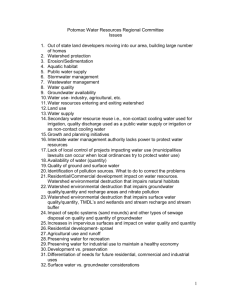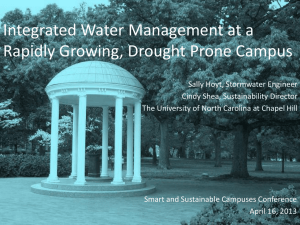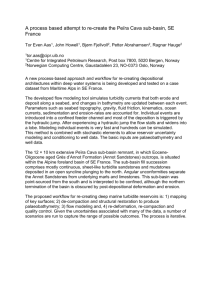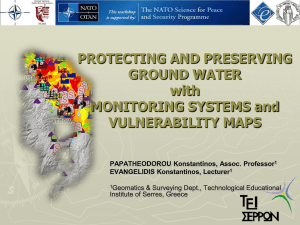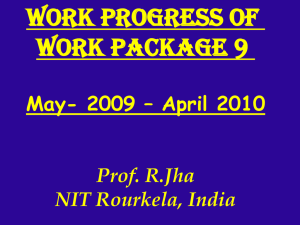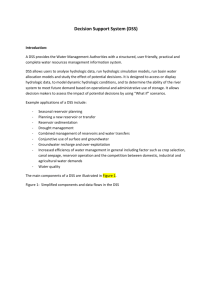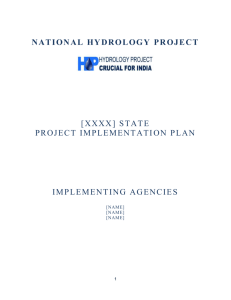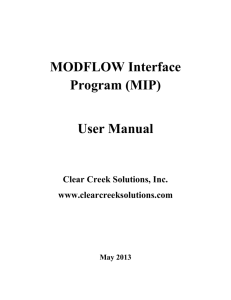Word - DEP
advertisement
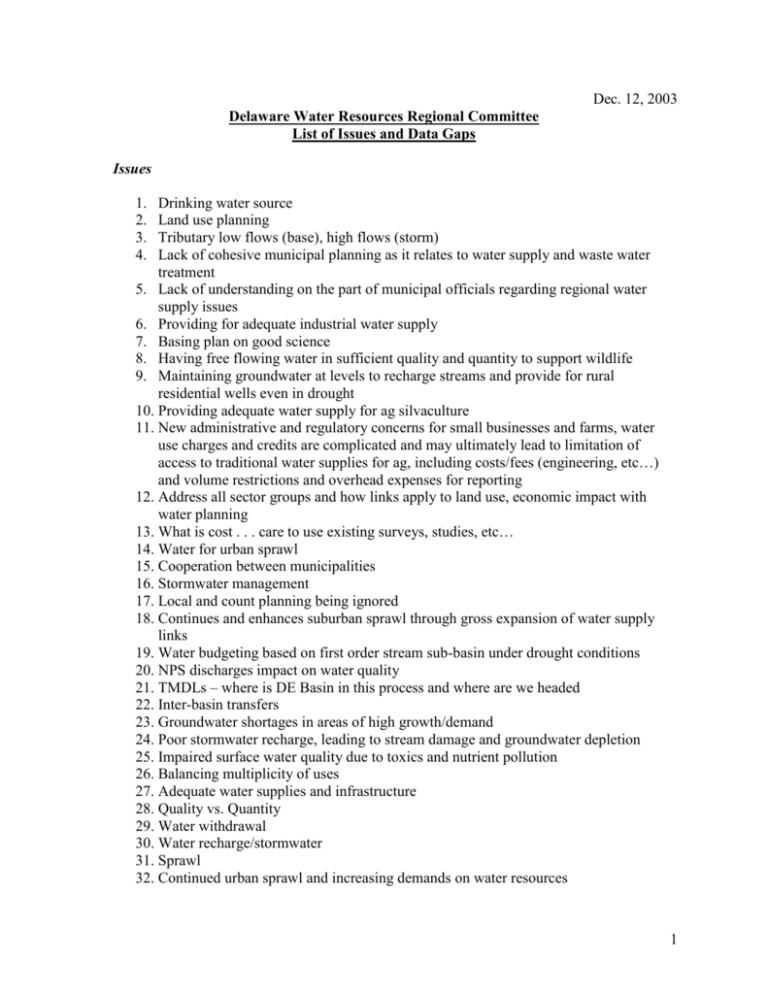
Dec. 12, 2003 Delaware Water Resources Regional Committee List of Issues and Data Gaps Issues 1. 2. 3. 4. Drinking water source Land use planning Tributary low flows (base), high flows (storm) Lack of cohesive municipal planning as it relates to water supply and waste water treatment 5. Lack of understanding on the part of municipal officials regarding regional water supply issues 6. Providing for adequate industrial water supply 7. Basing plan on good science 8. Having free flowing water in sufficient quality and quantity to support wildlife 9. Maintaining groundwater at levels to recharge streams and provide for rural residential wells even in drought 10. Providing adequate water supply for ag silvaculture 11. New administrative and regulatory concerns for small businesses and farms, water use charges and credits are complicated and may ultimately lead to limitation of access to traditional water supplies for ag, including costs/fees (engineering, etc…) and volume restrictions and overhead expenses for reporting 12. Address all sector groups and how links apply to land use, economic impact with water planning 13. What is cost . . . care to use existing surveys, studies, etc… 14. Water for urban sprawl 15. Cooperation between municipalities 16. Stormwater management 17. Local and count planning being ignored 18. Continues and enhances suburban sprawl through gross expansion of water supply links 19. Water budgeting based on first order stream sub-basin under drought conditions 20. NPS discharges impact on water quality 21. TMDLs – where is DE Basin in this process and where are we headed 22. Inter-basin transfers 23. Groundwater shortages in areas of high growth/demand 24. Poor stormwater recharge, leading to stream damage and groundwater depletion 25. Impaired surface water quality due to toxics and nutrient pollution 26. Balancing multiplicity of uses 27. Adequate water supplies and infrastructure 28. Quality vs. Quantity 29. Water withdrawal 30. Water recharge/stormwater 31. Sprawl 32. Continued urban sprawl and increasing demands on water resources 1 33. Disconnect between land use planning at the local level and water use planning at the state/interstate levels 34. Limited stormwater management and lack of state funding (Act 167) 35. Lack of linkage between municipal land use zoning authority and water capacity issues 36. Lack of real local input into the withdrawal regulatory process 37. Lack of public acceptance/understanding of water budgeting 38. Water supply resources 39. Water need priorities 40. Quality/supply stewardship 41. Meet water supply needs during drought conditions 42. Maintain stream ecology during low-flow conditions 43. Stormwater management to address multiple objectives 44. Coordination of water withdrawals (outside DRBC jurisdiction) with Act 537 program – sewage facilities planning. (Keep water within watershed, especially in small first order headwater streams) 45. Sediment loadings to surface water and increased temps to baseflow 46. Land development and infrastructure going out to Non-Safe-Yield areas, reducing recharge opportunities 47. Sprawl – Land use 48. Capacity for economic development Drinking water supply Sewage treatment capacity All at the regular location/area 49. Periodic droughts – every 5 years or so, drought warnings 50. Use of, and sometimes reliance on, out-of-basin transfers. Has ecological impacts, destroys natural water budgets, more drought, and not sustainable 51. Failure to consider and regulate based on point source impacts and withdrawals on ecosystem, aquifers, streams, and all dependent on them 52. Failure to define strategies and put water back in the ground and use development and land use strategies that minimize increases in stormwater runoff and decrease of aquifer recharge 53. Look at state permit requirements and process that requires assessment of impacts, imposes limits and allowable withdrawals, that is enforceable and includes opportunities for public input; requirements should be for all withdrawals Data Gaps 1. Detailed groundwater and surface water flow data 2. Land use/zoning data 3. Databases and GIS mapping of all water suppliers and water quality management facilities and service areas 4. Watershed based water quality data 5. Tributary flow data 6. Tributary water budgets 2 7. Need a way to quantify more accurately “losses” – it’s frequently taken that all withdrawals go to beneficial use, but a portion usually goes to various types of losses (leakage, meter errors, etc…). Reducing loss recovers water resources 8. Comprehensive quantity/quality data 9. Detailed water use data by sector: rec., commercial, industrial, . . . 10. Water supply (GW & SW) graphed on geographic basis in flush conditions and in drought conditions 11. Water demands – now and projected based on future land use 12. Legal authorities and constraints on allocation 13. Water chemistry by region 14. Water consumption by region 15. Map of basin/sub-basins 16. Amount of surface water and ground water in basin 17. Amount of water being extracted/used 18. Amount of recharge 19. Basin water balance and sub-basins water balance 20. Water quality – where are there concerns 21. Numbers on water supply and demand basin-wide and by smaller sub-basin areas/watersheds 22. Trend data showing use by sub-basin areas/watersheds (usage over time by category of user for each sub-basin) 23. Recharge data by watershed/sub-basin 24. Available water supply 25. Projected uses/demand 26. Condition of infrastructure 27. Vision of future (re)development and need 28. Amount of water available 29. Instream flow needs for warm water fisheries 30. Consumptive water usage (insufficient knowledge of) 31. Good maps of sub-basin and watersheds in the Delaware Basin 32. Instream flow data of waste water facilities 33. Latest mapping 34. Competitive withdrawal (groundwater) in formation 35. Historical low or no-flow stream 36. Identifying critical natural water resources for conservation protection 37. Identify critical water shortage areas 38. Identify existing public water facilities, lines, and service areas 39. Where is the water? 3-D perspective 40. Current shortages 41. Future shortages 42. Water use (current). Particularly for ag and quarries 43. Relevant county and municipal plans (land use) growth projections 44. Water use trends impact of policies and technology 45. MS4 – who has them, who doesn’t 46. Flood plain designation overlaid with PEMA/FEMA disaster areas 47. Infiltration standards in karst geology 3 48. Impacts of water withdrawal on ecological health of stream, aquifers, groundwater, wetlands, ecosystems 49. Impacts on waterways (ground and surface) from future development and community planning documents 50. Updated science on target flows that drive water withdrawals 4 5
